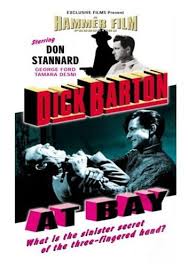
Professor Mitchell (Percy Walsh) is a renowned scientist who lives with his adult daughter Mary (Joyce Linden). The professor is the inventor of what is referred to as the deadliest machine known to man. It is a sort of death ray that can destroy unstable compounds. The machine has a capability radius of twenty miles. The purpose of the ray is to protect England’s shores from attack. Professor Mitchell says that positioning a device every twenty miles along the shoreline would ensure that no enemy planes or bombs could infiltrate the barrier around the country.
Special Agent Dick Barton (Don Stannard) and his associate, Snowey White (George Ford), are assigned to protect Mitchell and his invention. Serge Volkoff (Meinhart Maur) is an agent for a foreign and malevolent government. Volkoff sends one of his goons to kill Barton. Barton, suspecting an attack, is prepared and fools the would-be assassin into thinking he has accomplished his errand.
Aware of Mitchell’s invention, Volkoff kidnaps the scientist and Mary. Volkoff and his minions take Mitchell and his daughter to a lighthouse off the shore of England. Volkoff tests the device by bringing down a passing plane and crashing it into the countryside. With that success behind him, Volkoff plans on using the device to destroy a squadron of airplanes with a group of top military brass aboard on their way to a secret meeting. If Volkoff manages to destroy the planes, it could trigger the start of WW III.
“Dick Barton At Bay” was released in 1950 and was directed by Godfrey Grayson. It is a British crime thriller with science fiction aspects. The film was produced by Hammer Film Studios.
Three Dick Barton films were done by Hammer Studios after purchasing the rights from the Dick Barton radio series. This was the second film shot, but the third film released. The other two films were “Dick Barton: Special Agent” 1948 and “Dick Barton Strikes Back” 1949. A fourth film, “Dick Barton in Darkest Africa” was planned, but the death of leading star, Don Stannard, spelled the end to any sequels.
As a sequel, the film better than the first film, but less interesting than the second released film. The sound is muffled in many spots. All of the Dick Barton films could use some restoration, but I doubt that one will be done any time soon. Unlike the first film, this one did away with the slapstick humor and plays the story straight.
The movie suffers a little from some lackluster acting and some logic leaping plot aspects. It also had some budget restraints that make the film seem more like a quota quickie than a Hammer film. All three movies are filmed with the assumption that everyone knows who Dick Barton is. This is fine for Britain where everyone actually does know who Dick Barton is but in the U.S. the radio programs were more like “The Shadow”. Still, Dick Barton is often considered the precursor to another British spy that the world knows, James Bond.
The theme music for the films as well as for the radio show is from “The Devil’s Gallop” by Charles Williams. The radio program ran from 1946 to 1951 and encompassed 711 fifteen-minute episodes. A television series was also produced. It ran for only one season but had 32 fifteen-minute episodes.
Movie
Devil's Gallop theme

